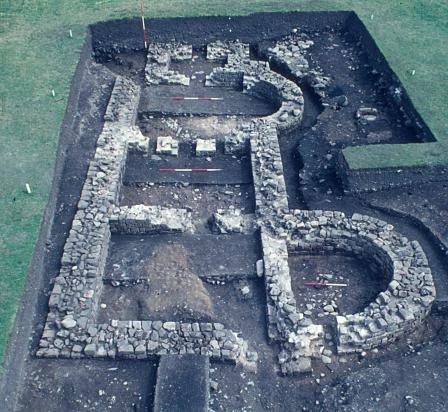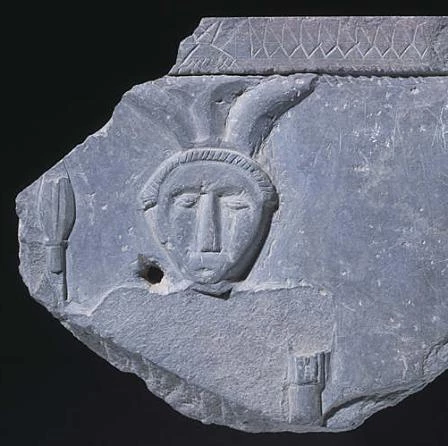Segontium - Y Rhufeiniaid yng Ngogledd Cymru
Awyrlun o Segontium yn dangos ei ffurf hirsgwar sy'n nodweddiadol o gaerau Rhufeinig. Mae nifer o'i hadeiladau cerrig wedi'i datgladdu fel y gall y cyhoedd eu gweld. Llun: Cadw (Hawlfraint y Goron).
R. E. M. Wheeler yng nghwmni'r Foneddiges Lloyd George (de pellaf) yn Segontium ym 1922. Llun © Casgliad preifat.
Yn gynnar yn y bedwaredd ganrif dechreuwyd codi baddondy yng nghornel dde-ddwyreiniol y gaer. Ni chwblhawyd yr adeilad.
Addolai milwyr Rhufeinig nifer o dduwiau. Mae'r gerfwedd hon o Segontium yn portreadu Mawrth, duw rhyfel ac, ar rai adegau, dduw iachau.
Sefydlwyd caer Rufeinig Segontium yn OC77 ac roedd garsiwn yno hyd tua OC394. Ni feddiannwyd unrhyw gaer Rufeinig arall yng Nghymru am gymaint o amser.
O'r afon y daw enw Segontium: 'grymus' yw ystyr 'sego-', elfen sydd ynghudd yn yr enw Seiont. Mae i'r gaer, un o'r enwocaf ym Mhrydain, leoliad allweddol yn y rhwydwaith milwrol Rhufeinig, gan ei bod mewn man canolog ar brif ffyrdd arfordir y gogledd a'r gorllewin. Mae'r gaer yn sefyll ar gopa bryn llydan a chrwn sy'n edrych dros afon Menai ac Ynys Môn.
Datgelodd gwaith cloddio archaeolegol a wnaed rhwng 1975 a 1979 nifer o flociau o farics pren yn y chwarter de-ddwyreiniol oedd yn dyddio o ddiwedd y ganrif gyntaf a blynyddoedd cynnar yr ail ganrif OC. Mae hyn yn dangos bod y gaer wedi cael ei chynllunio i letya 'cohors milliaria', sef catrawd o filwyr traed cynorthwyol oedd yn cynnwys hyd at 1,000 o ddynion.
Mae tystiolaeth bendant fod maint y garsiwn yn llai o lawer erbyn tua OC 120. Ganol yr ail ganrif codwyd tŷ cwrt mawr, a chanddo'i faddondy bach ei hun, yn y gornel dde-ddwyreiniol. Mae'n bosibl mai cartref swyddog pwysig a oedd, efallai, yn gyfrifol am gloddio mwynau yn yr ardal oedd y tŷ trawiadol hwn.
Yn gynnar yn y drydedd ganrif, y garsiwn oedd Cohort Cyntaf Sunici, catrawd o 500 o filwyr traed gafodd ei recriwtio yn yr Almaen. Mae enw'r uned yn ymddangos mewn arysgrif sy'n cofnodi atgyweirio traphont ddŵr y gaer tua OC200.
Roedd y garsiynau ar gyfer y rhan fwyaf o'r drydedd a'r bedwaredd ganrif yn llai o lawer. Yn ystod y cyfnod hwn prif swyddogaeth Segontium oedd amddiffyn arfordir gogledd Cymru rhag ysbeilwyr a môr-ladron o Iwerddon. Mae darnau arian a ffeindiwyd yn Segontium yn dangos bod milwyr yn y gaer allweddol hon tan OC394.
Yr angen i amddiffyn tiroedd ffrwythlon a llawn mwynau Môn sy'n esbonio'r preswyliad anarferol o hir hwn. Segontium oedd pencadlys milwrol a gweinyddol y gogledd-orllewin drwy gydol y cyfnod Rhufeinig.
Sicrhaodd adfeilion Segontium le iddi mewn chwedlau, ymhell ar ôl i'r milwr Rhufeinig olaf gefnu ar y gaer. Cyfeirir at Segontium ym Mreuddwyd Macsen, un o chwedlau'r Mabinogion.
Ni ddaeth arwyddocâd milwrol Caernarfon i ben ar ddiwedd y cyfnod Rhufeinig, oherwydd yn yr Oesoedd Canol sefydlwyd mwnt (twmpath y codwyd castell arno) Normanaidd ar lan aber afon Seiont ac yna, ar ddiwedd y drydedd ganrif ar ddeg, adeiladwyd castell enwog Edward I ynghyd â'r dref furiog sydd ynghlwm wrtho; ac yn olaf ym 1775 codwyd caer fach ger aber afon Menai.
Darllen Cefndir
Excavations at Segontium (Caernarfon) Roman Fort, 1975-1979', gan P. J. Casey a J. L. Davies. Cyhoeddwyd gan Council for British Archaeology (1993).
'Roman & Early Medieval Wales' gan C. J. Arnold a J. L. Davies. Sutton Publishing (2000).
'Segontium and the Roman Occupation of Wales' gan R. E. M. Wheeler. Yn Y Cymmrodor, cyf. 33 (1923).




sylw - (7)
Hi there Jack
Thanks for getting in touch. I'm sorry that you did not enjoy your visit to Segontium. If you have concerns about the safety of a scheduled ancient monument, please get in touch with Cadw, as they will be able to address these.
Over the last five years, we have invested £6million in the redevelopment of St Fagans National Museum of History, to allow the story of Wales to be told, from prehistory to present day. Our archaeology and numismatics collections will play a key role in telling this story. While I cannot guarantee which Roman objects may go on display (this is very much in the hands of our Curators at the moment), we are doing our very best to ensure that our visitors enjoy and learn from these wonderful collections. Additionally, we have recently secured funding to ensure that the Caerleon National Roman Legion Museum can undergo essential maintenance, to keep this resource about Roman Wales open to the public for years to come.
Thanks again for your enquiry.
Sara
Digital Team
I was horrified to see that there were places around the site in parts of areas of the fort, that had obviously been used for ad-hoc parties etc, as there was lots of broken bottles and beer cans etc. littering the whole site. Having talked to one of the men mowing the grass between the foundations of the fort, I discovered to my horror, that needles had also been discarded around the site, especially in the hedges that surround the (now defunct) Museum building!
I also obviously discovered, much to my dismay, that the Museum was closed down, and all artifacts taken to Cardiff. If this is true, where can one visit these artifacts now?
It does seem such a shame that such an amazing site should be left in such a poor situation.
Yours,
Jack Robinson.
Dear Mrs May,
Thank you for your enquiry about the Roman fort of Segontium that your grandfather saved for the nation and provided a site museum for.
As you correctly say the site was excavated in the early 1920s as it was threatened by housing development. The land had been bought just before the First World War, 1913, by a group of members of the Cambrian Archaeological Association to allow for excavations to take place, but these were then delayed the War. On the competition of the excavations in 1923 it would, at the time, have been normal for the land to be sold on and once again face the threat of development. It is at this point, 1925, that Mr Roberts bought the land to permanently preserve the site, giving it to the National Trust. He also funded the building of the museum on the site, but, according to our records this did not actually open until 1937.
In 1957 the site and the museum were placed under the guardianship of the then Ministry of Works (now Cadw) and in 1979 the National Museum took on full responsibility for the interior of the museum and its day to day operation. This situation continued until 2003 when the management of the museum was transferred to a new independent organization Segontium Cyf, with continued financial support for five years. The hope and plan was for the museum to be redeveloped during this period. Unfortunately this was never achieved and in late 2009, as the museum was going to be closed all winter, we removed all the small objects, for their safety. The museum in fact never reopened and the management of the building was returned to Cadw. At their request, in advance of proposed building work, we removed the reaming large objects in 2011. It now acts just as a visitors centre for the site, with no objects currently on display.
With sincere apologies for the delay in dealing with your enquiry.
Yours,
Evan
Dear Mrs May
Thank you for your comment and for your information about John R. Roberts. It's interesting to know the letters between him and the Clerk of Works still survive, I'm sure they provide great insight into the development of Segontium following the Mortimer Wheeler excavations.
I will pass on your comment to the relevant curator, to see if they can provide more information about the site, as you requested - I will pass on their response as soon as I get it.
Thanks again for your interest in this article and your interesting comments.
Sara
Digital Team
Theywere well known members, solicitors and shipping Agents living at Glendower by the Castle Gate. The Museum and site were handed over to the National Trust on my grandfather's death in 1926.
I believe a firm of Solicitors still practice in Llangefni.
It is the Museum I am interested in having visited it several years ago when told it was run by volunteers and artifacts were being moved to Cardiff.
I have many origianl letters between my grandfather and the Clerk of Works.
Please bring me up to date with the site and the Museum.
I look forward to your comments.
With regards,
Ella May